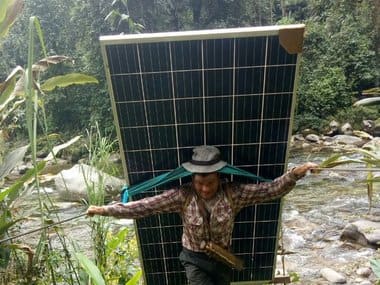In a country where millions of households are still without electricity, it is indeed a milestone to get the last village in darkness on to the national power grid. That’s the first step in the ultimate goal to provide electricity to each and every single house that exists on this land. With Leisang village in Manipur getting connected to the national power grid on 28 April, all Indian villages now have access to electricity. “One of the biggest election promises the Bharatiya Janata Party made before coming to power in 2014 — the promise of ensuring access to electricity for every village in India — was achieved on Saturday,” Prime Minister Narendra Modi said on Sunday.
28th April 2018 will be remembered as a historic day in the development journey of India. Yesterday, we fulfilled a commitment due to which the lives of several Indians will be transformed forever! I am delighted that every single village of India now has access to electricity.
— Narendra Modi (@narendramodi) April 29, 2018
After coming to power in 2014, the NDA government, through its rural electrification programme Deen Dayal Upadhyaya Gram Jyoti Yojna (DDUGJY), stepped up efforts to reach out to villages without electricity. The other objective of the scheme was to help improve India’s per capita power consumption of around 1200 kWh (kilowatt-hour, a measure of electrical energy). According to government data, all of the 597,464 census villages in India have been electrified. When the NDA government came to power in 2014, there were 18,452 un-electrified census villages. One may recall that Narendra Modi had promised to electrify all un-electrified villages within 1,000 days on his Independence Day address on 15 August 2015. [caption id=“attachment_4451463” align=“alignleft” width=“380”]  A man carrying equipment for electrification of villages. Image courtesy: Twitter/@narendramodi[/caption] “We had the instruction from the prime minister through our minister that all 18,452 un-electrified villages must be connected to the power grid before the completion of the government’s five-year tenure. All villages in the country must have electricity. Now it has been fulfilled. It’s more important to get connected with the national power grid first, which will improve per capita consumption of power. Gradually we can give connections to households and other bodies in villages,” a senior official working with DDUGJY told Firstpost. In a bid to give a boost to the rural electrification programme, Modi had launched the Saubhagya Yojna, which was an ambitious scheme to ensure g_har ghar bijli_ (Electricity for all homes). The prime minister had launched the scheme while inaugurating Deendayal Urja Bhawan — the corporate office of Oil and Natural Gas Corporation (ONGC) in September 2017. Later, in line with the prime minister’s announcement, the Power and Skill Development ministries joined hands in March to launch a skill development programme to speed up the implementation of the Saubhagya Yojna, the Modi government’s flagship universal household electrification programme. The objective of the Saubhagya Yojna or Pradhan Mantri Sahaj Bijli Har Ghar Yojna is to provide energy access to each household, the next step after getting all villages connected to the power grid. The scheme aims to take electricity connections to all remaining un-electrified households in rural as well as urban areas to achieve universal household electrification in the country. “This (initiative) has added a new chapter to our economic development. Our prime minister wanted a targeted approach so that the scheme could be implemented in a time-bound manner. His dream is to make electricity available to the poorest of poor across the country. It’s the first of its kind institutional effort where four stakeholders — the Centre, the states, Rural Electrification Corporation and National Skill Development Corporation have been brought together to implement this project. Besides providing electricity to the last person in the row — the poorest person, our focus is on developing skilled artisans,” Minister for Petroleum & Natural Gas and Skill Development and Entrepreneurship, Dharmendra Pradhan had said on the occasion. However, a day after Leisang village got electricity, the Congress party on Sunday questioned the authenticity of the prime minister’s claim. AICC in-charge, Communication, Randeep Singh Surjewala took to micro-blogging site Twitter and said —
2/2
— Randeep Singh Surjewala (@rssurjewala) April 29, 2018
Dear Modiji/Piyushji,
On 26th May,2014; only 18,452 villages were without electrification.
BJP Govt took 46 months to complete this at at an average of 4,813 villages per year.
This is - ‘celebrating inefficiencies’ & taking ‘fake credit’ for Congress work. pic.twitter.com/U270EK2pee
Dear Amit Shahji,
— Randeep Singh Surjewala (@rssurjewala) April 29, 2018
India has 6,49,867 villages. Congress connected 97% with electricity.
During UPA (2004-14), Congress electrified 1,07,600 villages.
In 60 yrs, Congress average is electrifying 10,000 villages per year.
Congress created #PowerfulIndia but didn’t boast!
1/2 pic.twitter.com/pktrzcqqD2
It is a fact that electricity is yet to reach 35 million families, as an article on LiveMint states. However, one should keep in mind the saying — “There are three types of lies — lies, damned lies, and statistics.” Under the garb of statistics, one can’t distort facts or achievements. Statistically comparing achievements of past Congress-led regimes as against the present NDA government would be splitting hair over a goal that both the government and the Opposition would agree is honourable.


)

)
)
)
)
)
)
)
)



